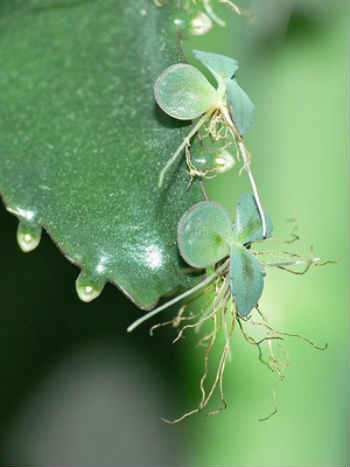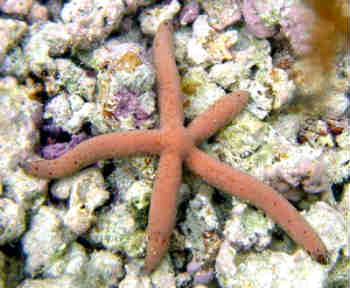On the Origins of New Forms of Life
4.1: Vegetative Reproduction
(Continued from the previous page)
 Vegetative reproduction in Kalanchoe pinnata Image: Stefan Walkowski
Vegetative reproduction in Kalanchoe pinnata Image: Stefan Walkowski
 The starfish Linckia multifora
voluntarily amputates an arm to reproduce. A complete new animal grows from the arm.
The starfish Linckia multifora
voluntarily amputates an arm to reproduce. A complete new animal grows from the arm.
In vegetative reproduction no embryo is produced. Reproduction instead proceeds by fragmentation. The growing organism breaks, or is broken, into two or more pieces, each of which lives on as an individual. Separation can be caused by forces external to the organism (e.g., a gardener taking a cutting from a plant). It can also involve the genetically programmed production of a process that detaches itself to live and mature separately (see figure at right). For example, a strawberry plant can send out a runner that then sprouts separate plants. Sea anemones, and many other types of organisms, reproduce by budding, a process in which a new individual grows out of the original organism.
In animals fragmentation can be voluntary. Thus, in some starfishes, for example Linckia multifora (right) and Echinaster luzonicus intentional amputation ("autotomy") occurs. One of the arms pulls itself away, regenerates, and forms a new animal. In others (e.g., Allostichaster polyplax and Coscinasterias calamaria) the body breaks itself into more equal parts. The missing parts then regenerate.
The various modes of apomixis should not be confused with hermaphroditism, where a single individual has both male and female sex organs, and where fertilization does in fact occur. Nor should it be equated with self-fertilization, which is a process undertaken by some types of hermaphrodites (for example, barnacles and many flowering plants).
Clones. When organisms reproduce agamospermously or vegetatively, they produce offspring genetically identical to themselves. Both an individual produced in this manner and the entire line of individuals produced in this way are called clones. Any process producing a new type of clone capable of self-replication produces an extremely stable new type of organism, so stable that different individuals are in fact genetically identical, or at least very nearly so. The only genetic differences are those that arise through rare mutations during, or subsequent to, the initial production of the clone. Any form that reproduces clonally (i.e., any apomict), once produced, would therefore be expected to show little or no variation over time. However, as we shall see, most clonal organisms of known origin and treated as species are derived from hybridization, and genetically distinct clones can be produced from hybrid crosses between the same two parent forms when different, genetically distinct, parental individuals are used. For example, different matings among hybrids in later generations, and backcrosses involving different later-generation hybrids, can produce distinct types of clones. In many cases, such clones differ among themselves, though each is a genetically invariant, stable, morphologically distinct lineage. Such naturally occurring arrays of clones ("clonal complexes") arising from later-generation hybridization may span much of the range of possible intermediate forms between the parents that originally crossed to produce the array. In contradistinction to a clone, breeders often call a hybrid line a strain when it is maintained by sexual, as opposed to apomictic, reproduction. NEXT PAGE >>
Most shared on Macroevolution.net:
Human Origins: Are we hybrids?
On the Origins of New Forms of Life
Mammalian Hybrids
Cat-rabbit Hybrids: Fact or fiction?
Famous Biologists
Dog-cow Hybrids
Georges Cuvier: A Biography
Prothero: A Rebuttal
Branches of Biology
Dog-fox Hybrids